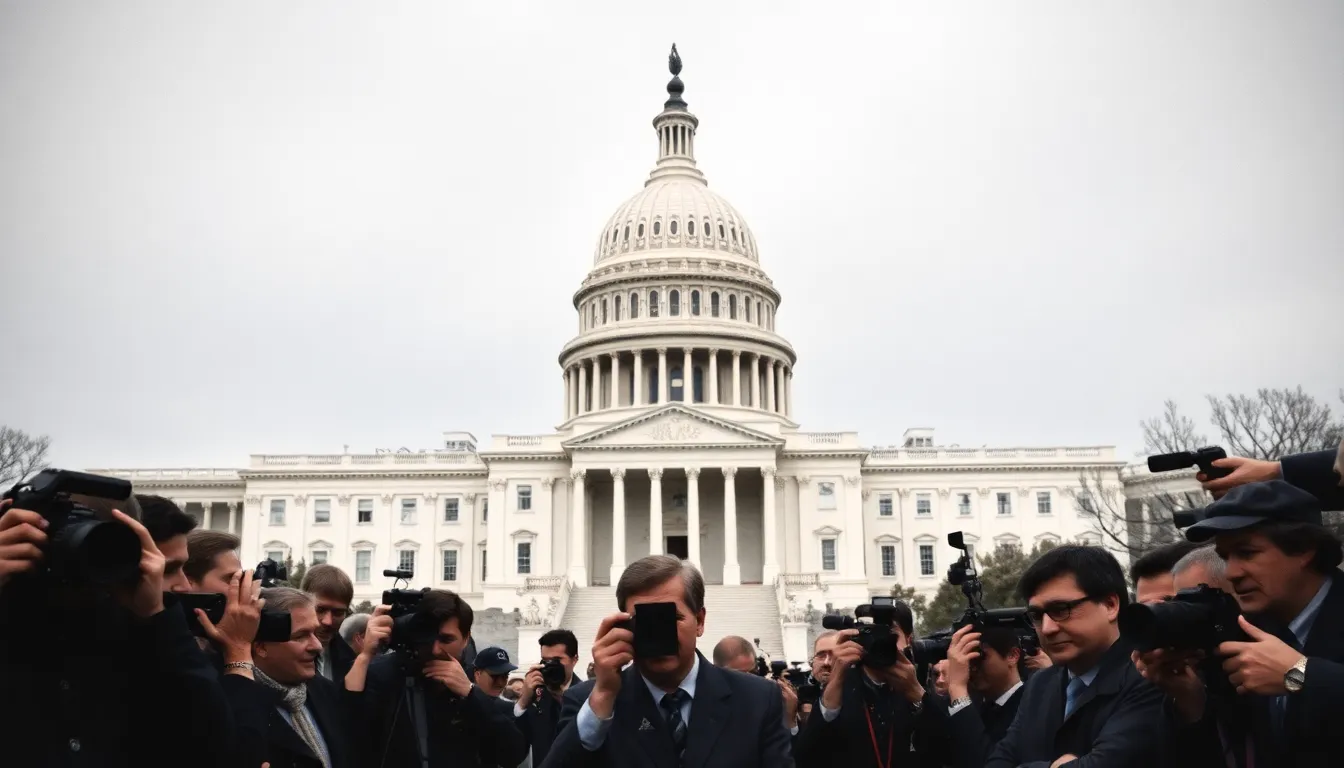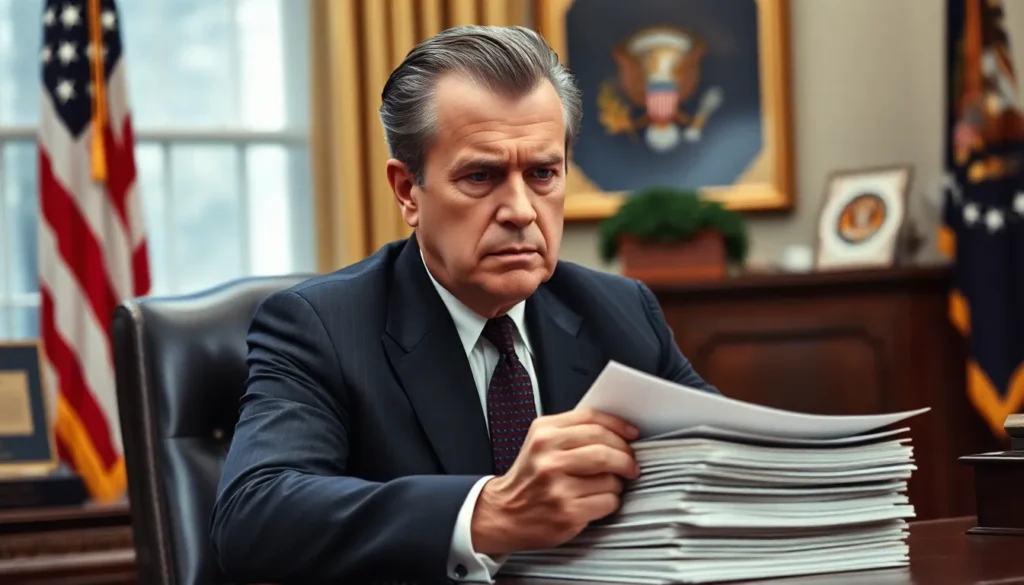In 1973, America was grooving to disco beats and enjoying the wonders of bell-bottoms, but one man was navigating the political dance floor: Richard Nixon. As the 37th president, Nixon was at the center of a whirlwind of events that shaped the nation, from the Vietnam War to the infamous Watergate scandal.
Table of Contents
ToggleOverview of Presidential History
Richard Nixon served as the 37th President of the United States from January 20, 1969, to August 9, 1974. His tenure marked a turbulent period in American history. The Vietnam War dominated the political landscape, influencing public opinion and shaping foreign policy. Nixon’s administration sought to achieve “peace with honor” in Vietnam while managing domestic unrest caused by anti-war protests.
In addition to foreign conflicts, the Watergate scandal loomed heavily over his presidency. This political crisis began with a break-in at the Democratic National Committee headquarters in June 1972 and developed into a series of revelations about abuse of power and cover-ups. The scandal eroded public trust in government, leading to widespread calls for accountability.
During Nixon’s presidency, economic challenges emerged, including inflation and energy crises. These issues affected American lives, prompting the implementation of wage and price controls to combat rising costs. As the public reacted to these changes, Nixon pursued various environmental and social reforms.
Key events also defined the era, such as the signing of the Paris Peace Accords in January 1973, marking a step towards the end of U.S. involvement in Vietnam. The historical implications of Nixon’s presidency continue to be analyzed and debated by scholars, providing insight into the complexities of leadership during challenging times.
The presidential history of Richard Nixon reflects pivotal moments that shaped the trajectory of the United States in the early 1970s. Events like the Watergate scandal and the Vietnam War were critical to understanding the social and political fabric of the nation during this era.
Key Events of 1973

The year 1973 featured crucial developments that shaped American society and political dynamics.
Watergate Scandal
Watergate began with the break-in at the Democratic National Committee headquarters on June 17, 1972. Legal investigations continued throughout 1973, leading to revelations that implicated President Nixon. Significant testimony from former White House aides eroded public trust in his administration. The Senate Watergate hearings garnered widespread media attention, highlighting corruption and abuse of power. In July, tape recordings from Nixon’s office emerged, confirming efforts to cover up the scandal. Legal battles intensified as calls for Nixon’s impeachment grew stronger. By the fall, the pressure on Nixon deepened, establishing Watergate as a pivotal moment in American political history.
Vietnam War Developments
Significant progress occurred in the Vietnam War during 1973. The Paris Peace Accords, signed on January 27, aimed to establish peace and allow U.S. troop withdrawal. Both North and South Vietnam agreed to cease hostilities, though fighting continued beyond the agreement. The agreement generated hope for an end to the conflict, yet uncertainty lingered over its implementation. American forces began withdrawing, and public sentiment regarding the war shifted dramatically. The legacy of the Vietnam War left a deep impact on U.S. foreign policy and military strategy, as the nation grappled with the war’s consequences.
Richard Nixon: A Profile
Richard Nixon served as the 37th president of the United States from January 20, 1969, to August 9, 1974. His presidency remains one of the most scrutinized in U.S. history, defined by the Vietnam War and the Watergate scandal.
Early Life and Political Career
Born on January 9, 1913, in Yorba Linda, California, Nixon grew up in a modest family. He attended Whittier College and later Duke University Law School. After World War II service in the Navy, he entered politics, winning a congressional seat in 1947. As a member of the House of Representatives, he gained national attention during the Alger Hiss Case. Nixon’s career progressed when he became the vice president under Dwight D. Eisenhower in 1953, allowing him to build a national profile before his successful presidential bid in 1968.
Presidential Policies and Achievements
Nixon’s presidency included significant foreign and domestic policies. He established a policy known as “Vietnamization,” aimed at reducing U.S. troop presence in Vietnam while strengthening South Vietnamese forces. On the international stage, Nixon made historic visits to China and the Soviet Union, fostering a policy of détente. Economic policies included wage and price controls to combat inflation, a move that showcased his focus on stabilizing the economy. The administration also saw notable advancements in environmental regulation, establishing the Environmental Protection Agency in 1970, reflecting an emerging awareness of environmental issues.
Public Perception of Nixon in 1973
In 1973, public perception of Richard Nixon polarized significantly amid the unfolding Watergate scandal and ongoing fallout from the Vietnam War. Approval ratings declined drastically as revelations emerged about his administration’s involvement in illegal activities.
Approval Ratings
Approval ratings for Nixon fell sharply throughout 1973. By April, polling data showed only 26% of Americans approved of his performance, a drastic decline from previous years. This decline stemmed from widespread disillusionment following the Watergate hearings and mounting concerns about the Vietnam War. Public sentiment shifted as citizens grew increasingly skeptical of government integrity and transparency. Higher dissatisfaction levels arose from the perception that Nixon misled the public about national issues. As a result, confidence in his leadership waned dramatically amid these challenges.
Media Coverage
Media coverage of Nixon’s presidency in 1973 intensified, particularly surrounding the Watergate scandal. Major news outlets like The Washington Post and CBS News dedicated extensive reporting to the emerging details of the cover-up. Investigative journalism played a crucial role in informing the public about Nixon’s actions and the implications for his presidency. The Senate Watergate hearings received extensive television coverage, drawing significant viewership and fueling public outrage. Graphic accounts from former aides and testimonies provided new insights, amplifying calls for accountability. Media scrutiny shaped public discourse and heightened distrust in Nixon’s administration.
The presidency of Richard Nixon in 1973 marked a turning point in American history. Amidst the chaos of the Watergate scandal and the challenges of the Vietnam War, Nixon’s leadership faced intense scrutiny. His efforts to navigate these crises left a lasting impact on public trust in government and shaped future political discourse.
As the nation grappled with economic difficulties and shifting cultural norms, Nixon’s decisions resonated deeply with the American public. The events of 1973 continue to serve as a reminder of the complexities of leadership during turbulent times and the profound effects of political accountability. Nixon’s legacy remains a subject of study and debate, reflecting the intricate interplay of power, trust, and the American experience.




